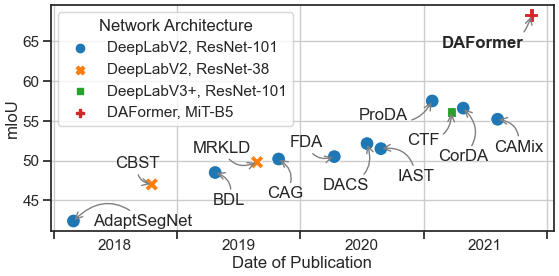Domain Adaptive and Generalizable Network Architectures and Training Strategies for Semantic Image Segmentation
Unsupervised domain adaptation (UDA) and domain generalization (DG) enable machine learning models trained on a source domain to perform well on unlabeled or even unseen target domains. As previous UDA&DG semantic segmentation methods are mostly based on outdated networks, we benchmark more recent architectures, reveal the potential of Transformers, and design the DAFormer network tailored for UDA&DG. It is enabled by three training strategies to avoid overfitting to the source domain: While (1) Rare Class Sampling mitigates the bias toward common source domain classes, (2) a Thing-Class ImageNet Feature Distance and (3) a learning rate warmup promote feature transfer from ImageNet pretraining. As UDA&DG are usually GPU memory intensive, most previous methods downscale or crop images. However, low-resolution predictions often fail to preserve fine details while models trained with cropped images fall short in capturing long-range, domain-robust context information. Therefore, we propose HRDA, a multi-resolution framework for UDA&DG, that combines the strengths of small high-resolution crops to preserve fine segmentation details and large low-resolution crops to capture long-range context dependencies with a learned scale attention. DAFormer and HRDA significantly improve the state-of-the-art UDA&DG by more than 10 mIoU on 5 different benchmarks. The implementation is available at https://github.com/lhoyer/HRDA.
PDF Abstract





 Cityscapes
Cityscapes
 SYNTHIA
SYNTHIA
 BDD100K
BDD100K
 Dark Zurich
Dark Zurich
